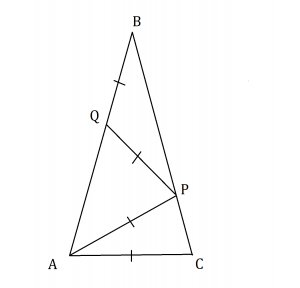1961 AHSME Problems/Problem 25
Problem
![]() is isosceles with base
is isosceles with base ![]() . Points
. Points ![]() and
and ![]() are respectively in
are respectively in ![]() and
and ![]() and such that
and such that ![]() .
The number of degrees in
.
The number of degrees in ![]() is:
is:
![]()
Solution
Let ![]() be the measure of
be the measure of ![]() .
. ![]() is an isosceles triangle, so
is an isosceles triangle, so ![]() and
and ![]() .
.
![]() is a line, so
is a line, so ![]() . Since
. Since ![]() is isosceles as well,
is isosceles as well, ![]() and
and ![]() .
.
![]() is a line, so
is a line, so ![]() . Since
. Since ![]() is isosceles as well,
is isosceles as well, ![]() .
. ![]() is also isosceles, so
is also isosceles, so ![]() , so
, so ![]() .
.
The angles in a triangle add up to ![]() degrees, so
degrees, so ![]() . Solving the equation yields
. Solving the equation yields ![]() . Thus,
. Thus, ![]() , so the answer is
, so the answer is ![]() .
.
See Also
| 1961 AHSC (Problems • Answer Key • Resources) | ||
| Preceded by Problem 24 |
Followed by Problem 26 | |
| 1 • 2 • 3 • 4 • 5 • 6 • 7 • 8 • 9 • 10 • 11 • 12 • 13 • 14 • 15 • 16 • 17 • 18 • 19 • 20 • 21 • 22 • 23 • 24 • 25 • 26 • 27 • 28 • 29 • 30 • 31 • 32 • 33 • 34 • 35 • 36 • 37 • 38 • 39 • 40 | ||
| All AHSME Problems and Solutions | ||
The problems on this page are copyrighted by the Mathematical Association of America's American Mathematics Competitions. 










